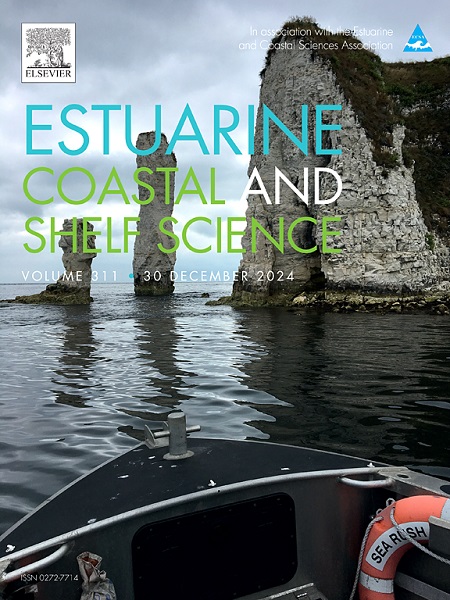韩国西海岸环境和寄生因素对马尼拉蛤生殖周期年际变化的影响
IF 2.6
3区 地球科学
Q1 MARINE & FRESHWATER BIOLOGY
引用次数: 0
摘要
大量研究表明,地理差异主要由环境因素驱动,影响马尼拉蛤(Ruditapes philippinarum)的生殖周期、配子体发生和产卵期。从2008年2月到2010年12月,我们在韩国西海岸Garorim湾的一个潮滩上监测了马尼拉蛤的年度繁殖周期。在成年雄性中,精子发生始于12月至2月,在3月和4月达到高峰(90%)。雄鱼的部分产卵发生在5月至7月,与此同时海水温度从11.2°C上升到20.0°C。雌性在1月至2月之间开始产卵,而在6月开始产卵,达到36%的活动高峰。2009年记录的产卵期只有3个月,而在其他年份,产卵期延长了4-5个月。条件指数(CI)范围在78 ~ 139之间,在产卵季节CI的波动表明雄蛤为多峰产卵,雌蛤为单峰产卵。原生动物寄生虫的感染强度为每克鳃组织0至1.4 × 105个细胞,与西海岸其他潮滩的蛤相比,感染水平较低。总体而言,研究地点生殖阶段和CI的变化似乎主要受水温和食物供应的季节性波动的影响,寄生虫感染的影响可以忽略不计。本文章由计算机程序翻译,如有差异,请以英文原文为准。

Interannual variability in the reproductive cycle of Manila clam, (Ruditapes philippinarum) influenced by environmental and parasitic factors on the west coast of Korea
Extensive studies have shown that geographic variation, primarily driven by environmental factors, affects the reproductive cycle duration, gametogenesis, and spawning periods of the Manila clam, Ruditapes philippinarum. From February 2008 to December 2010, we monitored the annual reproductive cycle of Manila clams on a tidal flat in Garorim Bay, located on Korea's west coast. In adult males, spermatogenesis began between December and February, reaching a peak (90 %) by March and April. Partial spawning in males occurred from May to July, coinciding with seawater temperatures rising from 11.2 to 20.0 °C. In females, oogenesis commenced between January and February, while spawning began in June, reaching a peak activity level of 36 %.A brief 3-month spawning period was recorded in 2009, while in other years, spawning extended for 4–5 months. The condition index (CI) of the clams ranged from 78 to 139, and fluctuations in CI during the spawning season indicated multiple spawning peaks in males, while females exhibited a single peak. The intensity of the protozoan parasite Perkinsus olseni infection ranged from 0 to 1.4x105 cells per gram of gill tissue, reflecting a low infection level compared to clams from other tidal flats on the west coast. Overall, variations in reproductive stages and CI at the study site appeared to be primarily influenced by seasonal fluctuations in water temperature and food availability, with negligible impact from parasite infection.
求助全文
通过发布文献求助,成功后即可免费获取论文全文。
去求助
来源期刊
CiteScore
5.60
自引率
7.10%
发文量
374
审稿时长
9 months
期刊介绍:
Estuarine, Coastal and Shelf Science is an international multidisciplinary journal devoted to the analysis of saline water phenomena ranging from the outer edge of the continental shelf to the upper limits of the tidal zone. The journal provides a unique forum, unifying the multidisciplinary approaches to the study of the oceanography of estuaries, coastal zones, and continental shelf seas. It features original research papers, review papers and short communications treating such disciplines as zoology, botany, geology, sedimentology, physical oceanography.

 求助内容:
求助内容: 应助结果提醒方式:
应助结果提醒方式:


